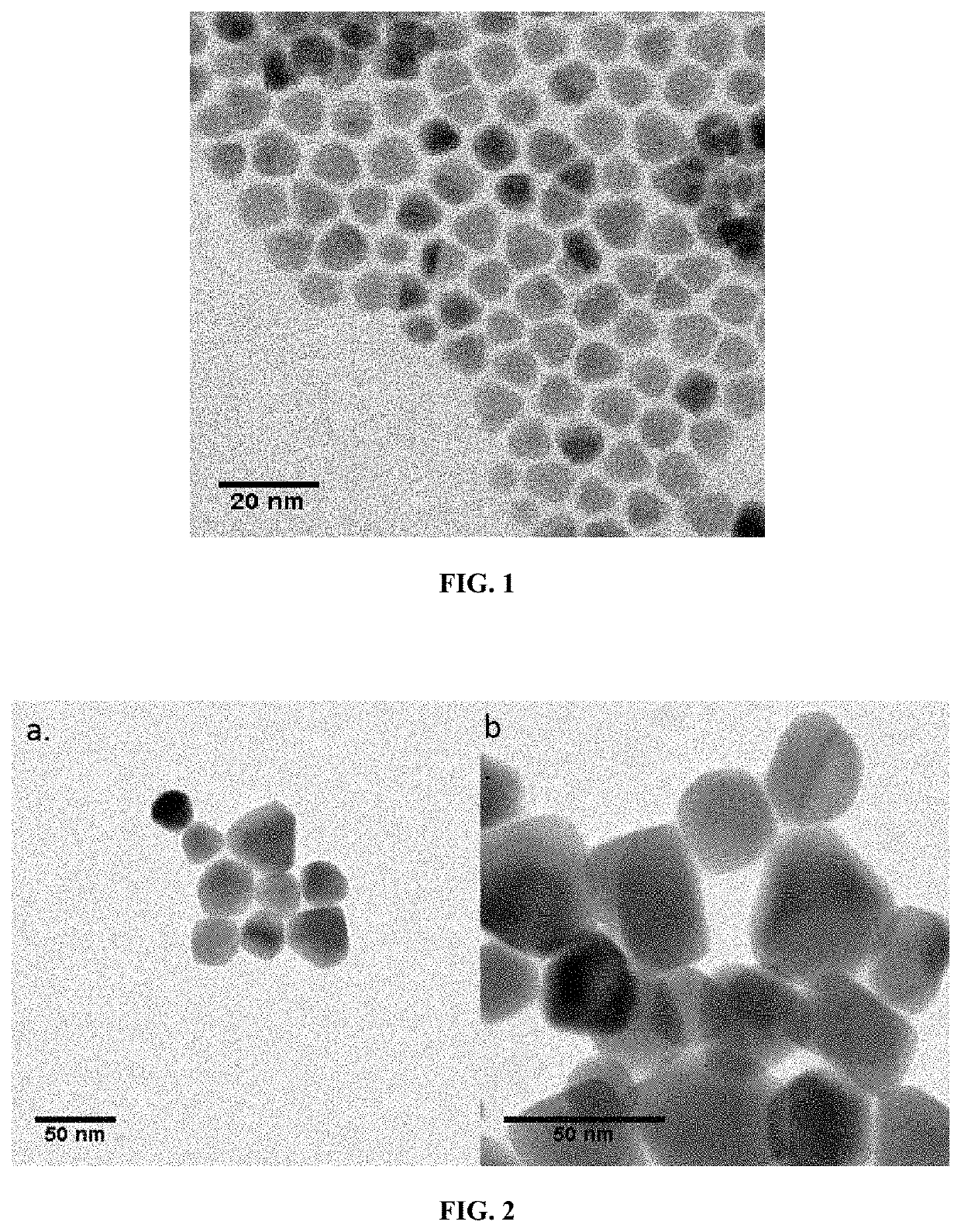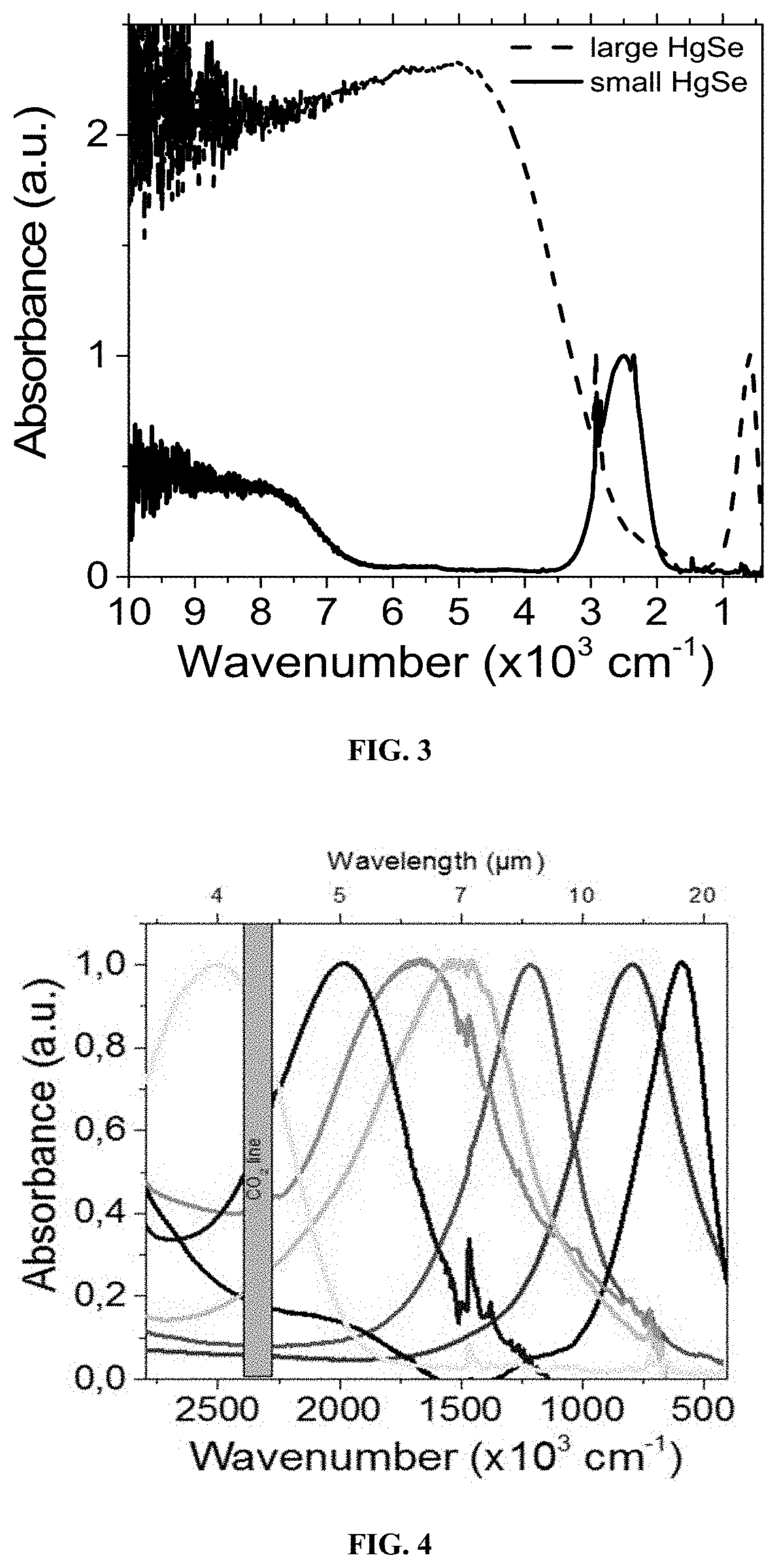Mid and far-infrared nanocrystals based photodetectors with enhanced performances
a nanocrystal and photodetector technology, applied in the field of infrared imaging, can solve the problems of inefficient organic electronic, high cost technology, and inability to meet the requirements of the spectrum of wavelengths, and achieve the effect of reducing the majority carrier current and reducing the dark curren
- Summary
- Abstract
- Description
- Claims
- Application Information
AI Technical Summary
Benefits of technology
Problems solved by technology
Method used
Image
Examples
example 1
crystal Synthesis—2 Step Synthesis
[0273]In a 50 mL three necks flask, 2 g of mercury acetate (Hg(OAc)2) and 80 mL of oleic acid are degassed at 85° C. under vacuum for 30 min. the obtained stock solution is transparent yellowish. 4 mL of this solution are mixed with 10 mL of oleylamine and degassed at 85° C. for 30 min. Meanwhile 1.58 g of Se powder is dissolved by sonication in 20 mL of trioctylphosphine (TOPSe). The final solution is clear and transparent. Under Ar at a temperature between 60 and 130° C., 1 mL of TOPSe is injected in the flask containing the Hg precursor. The mixture immediately turns dark; the reaction is performed for 30 s to 60 min. Then 1 mL of dodecanethiol is injected to quench the reaction and the flask quickly cooled down using fresh air flow. The content of the flask was split into 50 mL tube and ethanol is added to precipitate the nanoparticle. After centrifugation for 5 min at 5000 rpm, the clear supernatant is trashed and the pellet redissolved in 10 m...
example 2
rystal Synthesis—2 Step Synthesis
[0274]In a 50 mL three necks flask, 2 g of mercury acetate and 80 mL of oleic acid are degassed at 85° C. under vacuum for 30 min. the obtained stock solution is transparent yellowish. 4 mL of this solution are mixed with 10 mL of oleylamine and degassed at 85° C. for 30 min. Meanwhile 11 mg of Sulfur powder are dissolved by sonication in 3 mL of oleylamine. The final solution is clear and orange. Under Ar at a temperature between 60 and 120° C., the sulfur solution is injected in the flask containing the Hg precursor. The mixture immediately turns dark; the reaction is performed for 30 s to 60 min. Then 1 mL of dodecanethiol is injected to quench the reaction and the flask quickly cooled down using fresh air flow. The content of the flask was split into 50 mL tube and ethanol is added to precipitate the nanoparticle. After centrifugation for 5 min at 5000 rpm, the clear supernatant is trashed and the pellet redissolved in 10 mL clear toluene. This c...
example 3
crystal Synthesis—Quasi One Step
[0275]In a 25 mL three neck flask, 0.1 g of mercury acetate, 4 mL oleic acid and 10 mL oleylamine are degassed under vacuum at 85° C. for 30 min. The solution is clear and yellowish. Under Ar at the same temperature, 0.3 mL of TOPSe (1 M) is quickly injected. The solution turns dark immediately. Then 1 mL of dodecanethiol is injected to quench the reaction and the flask quickly cooled down using fresh air flow. The content of the flask was split into 50 mL tube and ethanol is added to precipitate the nanoparticle. After centrifugation for 5 min at 5000 rpm, the clear supernatant is trashed and the pellet redissolved in 10 mL clear toluene. This cleaning procedure is repeated for a second time using ethanol as non-solvent and toluene as good solvent. The pellet is again redissolved in toluene and 3 mL of acetone is added before centrifuging the solution. The formed pellet is saved and dried under nitrogen flow before being redissolved in toluene. 5 mL ...
PUM
| Property | Measurement | Unit |
|---|---|---|
| carrier mobility | aaaaa | aaaaa |
| temperature | aaaaa | aaaaa |
| thickness | aaaaa | aaaaa |
Abstract
Description
Claims
Application Information
 Login to View More
Login to View More - R&D
- Intellectual Property
- Life Sciences
- Materials
- Tech Scout
- Unparalleled Data Quality
- Higher Quality Content
- 60% Fewer Hallucinations
Browse by: Latest US Patents, China's latest patents, Technical Efficacy Thesaurus, Application Domain, Technology Topic, Popular Technical Reports.
© 2025 PatSnap. All rights reserved.Legal|Privacy policy|Modern Slavery Act Transparency Statement|Sitemap|About US| Contact US: help@patsnap.com



